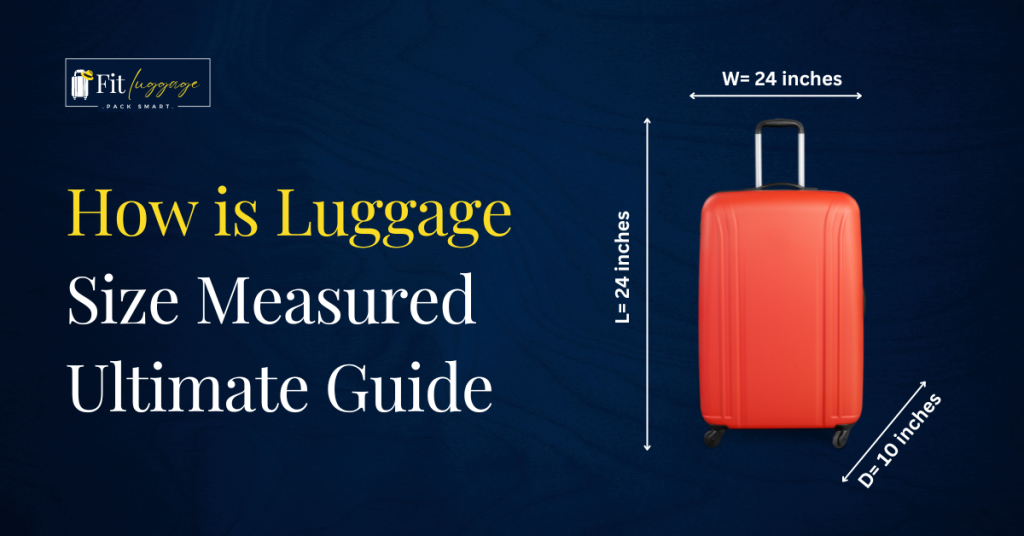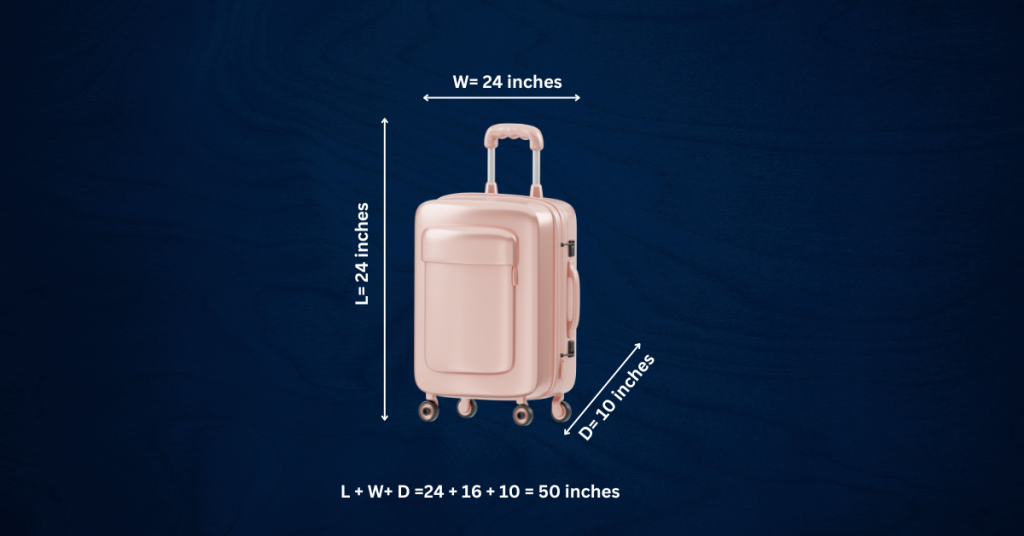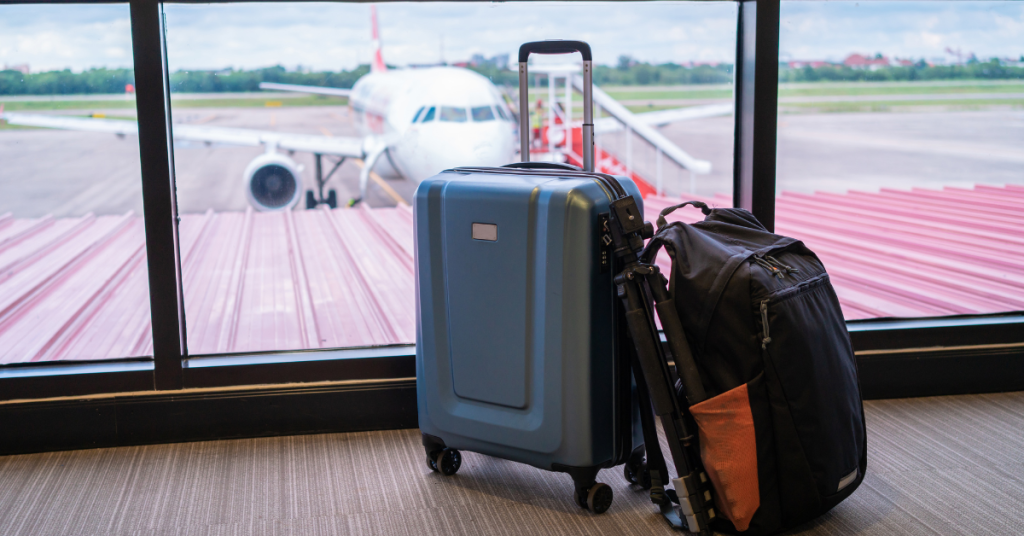Ah, the age-old question for every traveler: how is luggage size measured? Will your favorite suitcase fit in the airplane overhead compartment? Can you squeeze that extra pair of shoes into your checked bag without incurring an overweight fee? Fear not, weary wanderer! This comprehensive How is Luggage Size Measured guide will equip you with the knowledge and tools to navigate the sometimes-confusing world of luggage dimensions.

Also read: A Definitive Guide on How to Move Luggage From One State to Another 2024
Understanding the Lingo: Linear Inches and the All-Important Sum
Airlines primarily use a system called linear inches to determine luggage size. This refers to the sum of the length, width, and height of your suitcase, with all measurements taken in inches (of course, some airlines might use centimeters, so double-check!). Here’s where the magic (or maybe mild arithmetic) happens:
- Measure, Measure, Measure! Grab a trusty measuring tape and get ready to become a luggage measuring maestro. With your suitcase standing upright, wheels on the ground and handle collapsed, take the following measurements:
- Height: Measure from the base, including the wheels, all the way up to the highest point (usually the handle).
- Width: Standing directly in front of your suitcase, measure from one side to the other, ensuring any pockets or side handles are included.
- Length: This is the distance from the front of the suitcase to the back.
- The Grand Summation: Now comes the moment of truth! Add the three individual measurements (height + width + length) together. This combined figure is your luggage’s linear inch total.
Pro Tip: When measuring, don’t forget to account for any protruding elements like wheels, zippers, or external pockets. Airlines are sticklers for these details, and even a slightly oversized bag might get flagged for excess fees.

Airline Variations: A Gentle Reminder to Check and Recheck
While linear inches is the most common method, it’s crucial to remember that airline luggage size restrictions can vary. Some airlines might list a single linear inch limit for checked bags (often around 62 inches), while others might provide separate measurements for height, width, and length for both carry-on and checked luggage.
Here’s why vigilance is key: Imagine packing your perfect travel capsule only to discover at the airport that your beloved carry-on doesn’t meet the specific size requirements of your chosen airline. Disaster averted! Always check the baggage allowance information on the airline’s website before you pack. This will help you avoid any last-minute repacking woes and ensure a smooth check-in experience. For your convenience, many airlines offer a handy “baggage calculator” tool on their websites https://thepointsguy.com/guide/airline-baggage-fees/.
Remember: How is luggage size measured? By linear inches, but with a healthy dose of airline-specific verification!
Conquering Carry-on Conundrums: Size Does Matter
For carry-on luggage, the stakes are even higher. Those precious overhead compartments have limited space, and airlines are understandably strict about size restrictions. Here’s how to ensure your trusty carry-on becomes your travel companion, not a checked baggage liability:
- Know Your Airline’s Carry-on Policy: This is gospel for carry-on success. Every airline has a dedicated baggage allowance section on their website that outlines the specific dimensions and weight limits for carry-on luggage. Write down the measurements or take a screenshot for easy reference.
- Measure Twice, Pack Once: Here’s where understanding How is Luggage Size Measured becomes particularly important for carry-on bags. Following the linear inch method described earlier, meticulously measure your carry-on luggage. If even one dimension exceeds the airline’s limit, you might have to consider a different bag or do some strategic repacking.
- Consider Expandable Options: Expandable suitcases offer a bit of flexibility, allowing you to add some extra packing space if needed. However, be mindful of the airline’s restrictions when the suitcase is fully expanded. Don’t get caught in a situation where the expanded size pushes your carry-on over the limit.
Remember: How is luggage size measured for carry-on luggage? The same way as checked luggage (linear inches!), but with a keen eye for airline-specific size restrictions.

Packing Peace of Mind: Pro Tips for Navigating Luggage Size
Now that you’ve mastered the art of How is Luggage Size Measured, let’s equip you with some pro tips to ensure a stress-free packing experience:
- Invest in a Luggage Scale: Weight restrictions are just as important as size limitations. A portable luggage scale allows you to weigh your bags before you head to the airport, saving you from any unexpected overweight fees at check-in. Consider purchasing a digital scale with a hook for easy hanging and weighing of your luggage.
- Pack Like a Pro: Utilize space-saving packing techniques like rolling clothes instead of folding them. Compression packing cubes can also be a game-changer, helping you maximize space within your luggage. For visual learners, there are numerous packing tutorials available online https://m.youtube.com/watch?v=_kqb8ps6yDU that demonstrate these space-saving techniques.
- Utilize Packing Organizers: Packing organizers keep your belongings neatly compartmentalized, making it easier to find what you need and preventing clothes from getting wrinkled during travel. Consider using separate organizers for clothes, toiletries, and electronics for a more organized packing experience.
- Double-Check Carry-on Contents: Remember, certain items might have restrictions for carry-on luggage. Liquids, gels, and aerosols must adhere to the 3-1-1 rule (3.4 ounces or less per container, all in a one-quart resealable bag). Pack these items in your checked luggage if they exceed the carry-on limits. For the latest information on TSA regulations for carry-on luggage, you can visit the Transportation Security Administration (TSA) website https://www.tsa.gov/.
- Consider a Personal Item: Many airlines allow a personal item in addition to your carry-on luggage. This could be a small backpack, purse, or laptop bag. Utilize this space for essentials you might need during the flight, like a book, headphones, or medication.
Remember: How is luggage size measured? You’ve got this! By following these tips and understanding the concept of linear inches, you can pack with confidence and avoid any luggage-related mishaps at the airport.

Beyond the Basics: A Look at Different Luggage Types
With a diverse range of luggage options available, understanding the different types can help you choose the perfect travel companion for your needs:
- Hardside Luggage: Offering superior protection for your belongings, hardside suitcases are often made of polycarbonate or ABS plastic. They are generally more scratch-resistant and water-resistant than softside options.
- Softside Luggage: Softside suitcases, typically made of nylon or polyester, offer greater flexibility and often weigh less than hardside options. They can sometimes expand to accommodate extra packing needs.
- Spinner Luggage: Featuring spinner wheels that rotate 360 degrees, spinner luggage offers superior maneuverability, making it easier to navigate through crowded airports. Consider the terrain you’ll be navigating on your trip; spinner wheels might be especially helpful for navigating cobblestone streets or uneven sidewalks.
- Carry-on Luggage: Designed to fit within the overhead compartments of airplanes, carry-on luggage allows you to keep your essential items with you during your flight. Double-check the airline’s size and weight restrictions for carry-on luggage before your trip to avoid any surprises at the gate.
- Checked Luggage: Checked luggage offers more packing space for longer trips or when you need to bring bulkier items. However, remember to check the airline’s specific size and weight restrictions for checked baggage to avoid excess baggage fees.
Remember: How is luggage size measured? Regardless of the type of luggage you choose, understanding linear inches is key to ensuring a smooth travel experience.
Conclusion: A Farewell to Luggage Woes
By mastering the art of How is Luggage Size Measured, you can conquer carry-on chaos and checked baggage blues. With the knowledge and tools provided in this comprehensive guide, you can pack with confidence, navigate airport check-in with ease, and embark on your journey with peace of mind. So, pack your bags, embrace the adventure, and happy travels!
Frequently Asked Questions (FAQ)
Q: How is luggage size measured for checked bags?
A: Checked luggage size is typically measured using the same linear inch method as carry-on luggage. However, some airlines might have specific size restrictions for height, width, and length.
Q: How is luggage size measured for carry-on bags?
A: Carry-on luggage size is measured the same way as checked luggage, using the sum of the length, width, and height in inches. However, airlines tend to be stricter with carry-on size restrictions due to limited overhead compartment space. Double-check the specific dimensions allowed by your chosen airline before packing your carry-on.
Q: What if my luggage exceeds the size or weight limit?
A: If your luggage exceeds the airline’s size or weight limit, you have a few options:
- Repack: Try to redistribute items between your carry-on and checked luggage (if applicable) to stay within the limits. Utilize packing cubes or space-saving techniques to maximize efficiency.
- Pay excess baggage fees: Most airlines allow you to pay excess baggage fees for overweight or oversized luggage. However, these fees can be significant, so it’s best to avoid them if possible.
- Ship your luggage: Consider shipping your luggage ahead of time, especially if you’re traveling for an extended period or bringing bulky items.
Q: Is there a standard size for carry-on luggage?
A: Unfortunately, there is no universal standard size for carry-on luggage. While many airlines allow similar dimensions (often around 22″ x 14″ x 9″), restrictions can vary. Always refer to the specific airline’s website for the latest information on carry-on size allowances.
Q: Where can I find information about airline baggage allowances?
A: Most airlines have a dedicated baggage allowance section on their website. This section will outline the specific size and weight restrictions for both carry-on and checked luggage. You can usually find this information under the “Travel Info” or “Baggage” section of the airline’s website.
Remember: By understanding How is Luggage Size Measured and familiarizing yourself with airline baggage allowances, you can pack with confidence and avoid any unwanted surprises at the airport. Now, go forth and conquer your travels!
